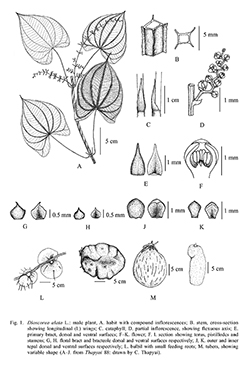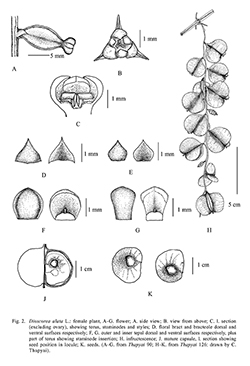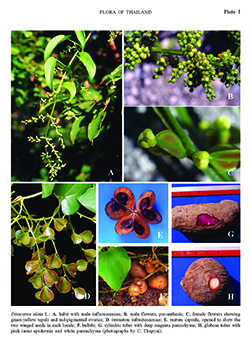e-Flora of Thailand
Volume 10 > Part 1 > Year 2009 > Page 11 > Dioscoreaceae > Dioscorea
1. Dioscorea alata L.wfo-0000388864
Sp. Pl. 2: 1033. 1753; Lour., Fl. Cochinch. 2: 765. 1793; Blume, Enum. Pl. Javae. 1: 22. 1827; Roxb., Fl. Ind. 3: 797. 1832; Hook.f., Fl. Brit. Ind. 6: 296. 1892; Ridl., Mat. Fl. Mal. Pen. 2: 84. 1907; Craib, Bull. Misc. Inform. Kew 1912: 406. 1912; Prain & Burkill, J. & Proc. Asiat. Soc. Bengal 10: 39. 1914; Burkill, Gard. Bull. Str. Settl. 1: 371. 1917; Gard. Bull. Str. Settl. 3: 4. 1923; Ridl., Fl. Malay Penin. 4: 319. 1924; R.Knuth in Engl., Pflanzenr. 4, 43: 265. 1924; Prain & Burkill, Bull. Misc. Inform. Kew 1927: 239. 1927; Prain & Burkill in Fl. Indo-Chine 6: 735. 1934; Burkill, Dict. 814. 1935; Prain & Burkill, Ann. Roy. Bot. Gard. (Calcutta) 14(2): 302. 1938; Burkill in Fl. Mal. 4, 3: 330. 1951; Backer in Fl. Jav. 3: 157. 1968; Hô, Câyco Viêtnam 3, 2: 927. 1993; Noltie in Fl. Bhutan 3(1): 14. 1994; Jayasuriya in Rev. Handb. Fl. Ceylon 9: 62. 1995; Ding & Gilbert in Fl. China 24: 297. 2000. Fig. 1, 2; Plate I.
Accepted Name : This is currently accepted.
Synonyms & Citations :
Description : Climber to 25 m. Tubers 1 to several, ca 10–50 by 5–30 cm, very variable in shape, in “wild” races usually cylindric to clavate, in cultivated races often globose to subglobose or clavate to digitate, known to be lobed or branched in parts of its range (Prain & Burkill 1938), with any underground part being able to give rise to a new plant. Indumentum absent. Stems 5–15 mm in diam. at base, woody and spiny, right-twining, usually quadrangular in cross-section with a longitudinal wing on each angle (also petioles and often inflorescence axes). Leaves simple, opposite, blade ovate to broadly so on the lower stems, base often sagittate to auriculate, ovate with a cordate, rounded or truncate base on distal stems, chartaceous, (5–)7–9-veined, margins entire, apex acuminate; lateral nodal flanges present as a membranous semi-circular or auriculate wing at each node; cataphylls 6–10 by 2.5–4 mm, lanceolate to narrowly ovate; bulbils present in many cultivated races, 2–7 cm in diam., globose or subglobose to clavate, grey brown to dark brown with a smooth or finely warty epidermis. Inflorescences pendent, spicate; male simple ((1–)2–6(–10) per axil) or compound (1–2 per axil); partial/simple inflorescence axes flexuous; female inflorescences simple, 1(–2) per axil, elongating in fruit. Male flowers with outer tepals, 1.3–1.6 by 1.0–1.3 mm, broadly obovate, inner tepals 0.9–1.1 by 0.8–0.9 mm, obovate to shortly spatulate; stamens 6, erect. Female flowers as in Fig. 2A–G, Pl. 1C. Capsules as in Fig. 2H, Pl. 1E, J, 18–23 by 25.5–43.5 mm. Seeds (Fig. 2K) 5–7.5 by 5–6.3 mm, wings 18–21.5 by 15–21.5 mm, all around seed margin.
Thailand : NORTHERN: Mae Hong Son (Pang Mapha), Chiang Mai (Doi Chiang Dao, Doi Inthanon, Doi Luang, Doi Suthep-Pui, Doi Chang Liang, Mae Ai, Ban Mae Klang, Huai Nam Mae Pern, Ban Chang Khan, Ban San Phayom), Lamphun (Mae Tha), Lampang (Doi Khun Tan, Chae Son, Chae Hom), Phrae (Mae Yom, Song, Mae Khaem), Uttaradit (Ban Khok, Phu Soi Dao), Tak (Doi Musoe, Bhumiphol Dam, Nam Dip, Umphang), Phitsanulok (Kaeng So Pha, Thung Salaeng Luang); NORTH-EASTERN: Phetchabun (Chon Daen, Khao Kho), Loei (Dan Sai, Phu Kraduong, Wang Saphung, Pha Nok Khao), Sakon Nakhon (Phu Phan), Mukdahan, Khon Kaen (Chum Phae); EASTERN: Chaiyaphum (Phu Khiao, Chumpae), Nakhon Ratchasima (Khao Yai, Lat Bua Khao, Sikhio, Pak Thong Chai), Amnat Charoen (Chanuman), Ubon Ratchathani (Nam Tok Phranin); SOUTH-WESTERN: Uthai Thani (Huai Khakhaeng), Kanchanaburi (Thong Pha Phum, Sai Yok, Huai Bankau, Khao Thalu), Phetchaburi (Kaeng Krachan), Prachuap Khiri Khan (Pran Buri); CENTRAL: Lop Buri (Sup Champa), Saraburi (Ban Nong Bua, Muak Lek, Sam Lan), Krung Thep Maha Nakhon (Bangkok) (cultivated); SOUTH-EASTERN: Sa Kaeo (Aranya Prathet), Prachin Buri (Khao Yai), Chachoengsao (Ang Rue Nai, Phanom Sarakham), Chon Buri (Khao Khiao, Sri Racha, Nam Tok Chantaten, Phattaya), Chanthaburi (Pong Nam Ron); PENINSULAR: Nakhon Si Thammarat (Khao Pu Khao Ya, Khiriwong).
Distribution : A cultigen, probably of SE Asian origin, now pantropically cultivated for its tuber. Type: two syntypes, one from from Sri Lanka and one of unknown origin.
Ecology : Found in open degraded and disturbed areas, mixed deciduous forests, pine and hill evergreen forests and in cultivation, from near sea level to 1,250 m alt. Apparently “wild” plants are probably relicts of cultivation. These populations appear to reproduce sexually to a considerable extent in Thailand.
Vernacular : Man wai (มันหวาย), man khaeng chang (มันแข้งช้าง)(Chiang Mai); man khao wua (มันเขาวัว)(Chiang Mai, Lampang); man lueat (มันเลือด)(Phitsanulok); khruea man (เครือมัน)(Loei); man dam (มันดำ), man liam (มันเหลี่ยม)( Nakhon Ratchasima); man i chan (มันอีจาน)(Ubon Ratchathani); man luang (มันหลวง)(Prachuap Khiri Khan); man rak (มันรัก)(Saraburi); man long choeng (มันลองเชิง), man sao (มันเสา)(Bangkok, Saraburi); man khaem (มันแขม)(Sa Kaeo); man ngu (มันงู)(Chon Buri); man thu (มันทู่)(Nakhon Si Thammarat).
Uses: In Thailand, cultivation of Dioscorea alata is often relatively small-scale, for example in gardens with fruit crops. Both cultivated and apparently wild plants provide edible tubers which are available in local or roadside markets. In cultivated races, the tubers are never over 50 cm deep and shallowly horizontally buried, while in “wild” plants they descend vertically into the substrate to ca 150 cm. Propagation is usually by tubers or bulbils planted in rainy season. Some cultivated races do not produce flowers. The tubers are usually dug in the dry season the year after planting, when the above-ground parts have died back. They are peeled, sliced into small pieces and washed or soaked in water, then boiled or steamed as an alternative starch source to rice. Steamed or boiled D. alata tubers can be served with coconut and sugar or cooked as a dessert with sugar and coconut milk.
Conservation Status: IUCN red list category LC (IUCN 2001). Dioscorea alata is widespread and common, growing in most habitats except swampy areas. Nevertheless, there may well be endangered races or varieties in Thailand. This needs further investigation; ancient races may provide resistance genes to, for example, anthracnose for plant breeders.
Notes: This species is easily recognised by the four longitudinal wings on its stems and petioles.
A number of vernacular names are based on tuber shapes or parenchymatous tissue colours, for example when the tubers are cylindrical or clavate and vertically buried they are often known as Man Sao or column yam. If the tubers are globose they are called man chao (มันจาว) or man chao maphrao (มันจาวมะพร้าว) in which they are related to the soft yellow cotyledon inside the overripe coconut. An example of a name based on the reddish or magenta colour of the tuber is man lueat (มันเลือด) or man lueat kai (มันเลือดไก่) or (chicken’s) blood yam. It may also be called man kip (มันกีบ) for its winged stems.



